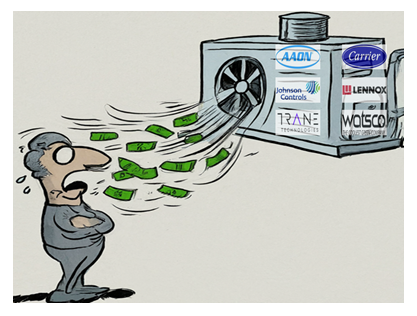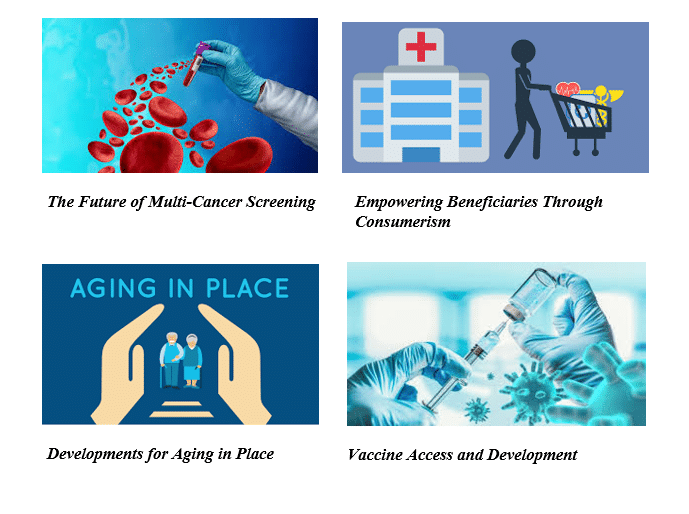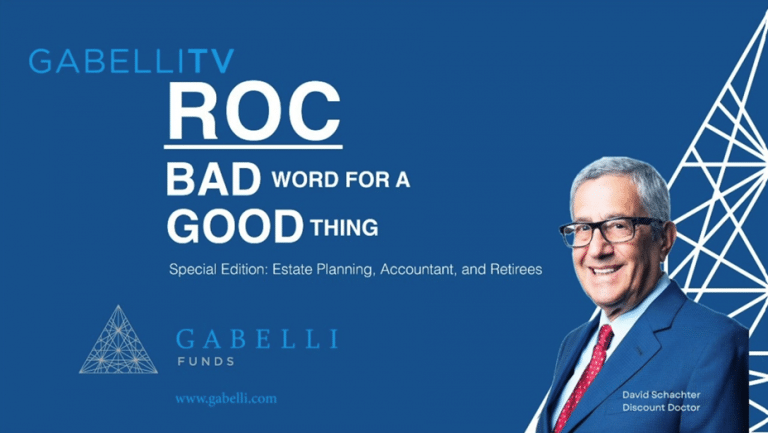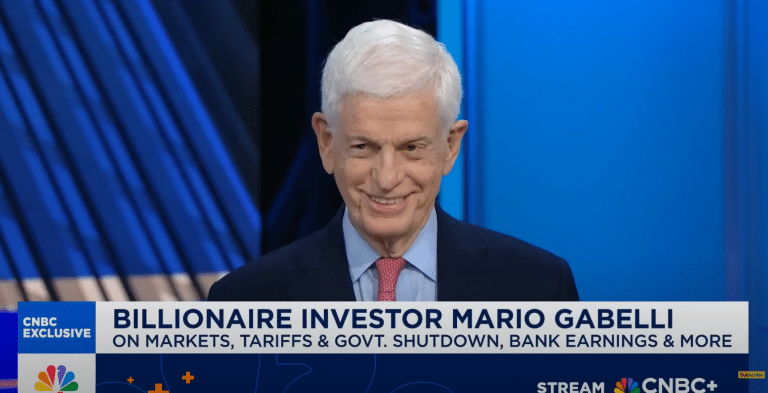The heating, ventilation, and air conditioning (HVAC) industry is a dynamic ecosystem where companies provide innovative products and services essential for maintaining indoor comfort and air quality. HVAC penetration in United States homes has steadily increased over the years and currently around 90% of homes have an HVAC system installed. According to Energy Information Administration data released in March of 2023, there were approximately 230 million central air conditioning and heating systems installed in the United States, with 102 million in service for more than 10 years. Companies involved play a crucial role in current long-term global trends such as environmental sustainability, changing regulatory frameworks, government incentives, artificial intelligence, and digitalization. We expect these mega-trends to provide steady demand for HVAC products and drive long-term growth for companies involved. Main players in the industry include AAON Inc. (AAON), Carrier Global (CARR), Johnson Controls (JCI), Lennox International (LII), Trane Technologies (TT), and Watsco (WSO).
History: The 20th and early 21st centuries marked a pivotal era of growth and innovation in the HVAC industry. In the U.S., the number of HVAC units in homes skyrocketed from under 50 million to over 200 million. This transformation began in 1902 when Willis Carrier invented the modern air conditioning system to regulate climate and humidity for printing plants. By the early 1900s, HVAC systems began to be adopted in public and manufacturing buildings, enhancing comfort and enabling longer operating hours. It wasn’t until after World War II that HVAC systems became widely used in residential homes, fueled by technological advancements that made them more affordable, along with population growth, urbanization, and a rising demand for comfort and indoor air quality. The energy crisis of the 1970s further accelerated innovation due to energy efficiency and environmental concerns being in the forefront of public awareness. Today, the industry is focused on sustainability, enhanced energy efficiency, digitalization, and smart connectivity.

Addressable Market: Currently, the global HVAC/R (includes refrigeration) market is estimated to be around $250 billion with WSO, the largest distributor in North America, estimating the North American HVAC/R market at roughly $64 billion. From 2010-2020, the market saw a mid-single-digit CAGR, however, COVID-19 accelerated this with the market growing at a low double-digit CAGR from 2020-2023. The market is expected to continue to grow at a mid to high single digit CAGR through 2030.
Sustainability
Environmental Impact: In TT’s May Investor presentation, the company estimated that 15% of global greenhouse gas emissions come from the heating and cooling of buildings. With this in mind, HVAC companies have joined the commitment to achieve net-zero greenhouse gas emissions by 2050. Many have also set the shorter-term goal of reducing their customers’ carbon footprint by one gigaton of CO2e (one billion metric tons) by 2030. To achieve these goals, companies continue to innovate products through improved system efficiency, the transition to low-GWP (Global Warming Potential) refrigerants, and the use of digital connectivity and AI to optimize heating and cooling. GWP is a measurement of how much energy the emission of 1 ton of a gas will absorb relative to the emission of 1 ton of carbon dioxide in a given time period, typically 100 years. The larger the GWP, the more that gas warms the Earth compared to carbon dioxide.
Cooling Degree Days: In recent decades, temperatures and cooling degree days (CDDs) have consistently risen. CDDs and heating degree days (HDDs) are calculated by comparing the average daily temperature to a standard of 65 degrees Fahrenheit. While CDDs have generally trended upward in the United States, there was a 4% year-over-year decline in 2023. However, early data from 2024 indicates a rebound, driven by widespread summer heatwaves. Elevated temperatures result in longer run times for HVAC systems, potentially shortening their lifespan. LII estimates that for every 5% increase in outside temperatures above 100 degrees Fahrenheit, HVAC systems experience an additional 17% wear and tear. This increased stress is expected to lead to higher service and emergency repair revenues, as well as more frequent system replacements.
{image and Table}


Transport Refrigeration (Cold Chain): CARR and TT are key players in the cold chain business, which involves a temperature-controlled supply chain designed to ensure the quality and safety of temperature-sensitive products. The food and beverage and pharmaceutical industries are particularly affected by these dynamics. Together, CARR and TT represent approximately 80% of the market in the Americas and 40-50% in the more fragmented EMEA market. Temperature-controlled solutions are integrated throughout the product journey, from containers on ships and cargo planes to refrigeration in trucks and trailers. CARR estimates that proper refrigeration and cold chain management could save around 475 million tons (approximately $200 billion) of food and $35 billion in pharmaceuticals each year. This food loss equates to about one billion metric tons of CO2-equivalent emissions, which TT estimates accounts for roughly 10% of global greenhouse gas emissions.

The annual addressable market for cold chain operations is approximately $35 billion and is growing at a mid-single-digit rate. Both CARR and TT provide comprehensive cold chain solutions, offering digital monitoring and temperature control for applications across air, sea, and land transport. Recent digital innovations have facilitated real-time visibility and insights into temperature analytics throughout a cargo’s journey, enabling customers to optimize cold chain operations. This leads to reduced product loss, lower costs, and fewer delays. The increasing demand for such technology is evident in the subscription data for CARR’s digital cold chain solution, Lynx, which boasted around 150,000 active users in Q2 2024—an increase of over 50% yoy.

Heat Pump Benefits: A key factor in reducing the global environmental impact of HVAC systems is the adoption of heat pumps. Unlike traditional HVAC systems, which generate heat by burning fossil fuels, heat pumps use electricity to transfer heat, resulting in greater efficiency and lower greenhouse gas emissions. These advantages extend throughout the year, as heat pumps provide both heating and cooling through advanced heat absorption technology.

All major OEMs are now producing heat pumps, recognizing it as a rapidly growing segment of the market. According to LII’s 2Q24 earnings call, heat pumps currently represent 30% of the market, valued at approximately $75 billion. The typical cost for a new system and installation ranges from $4,000 to $8,000, but can exceed $30,000 depending on the type of heat pump (geothermal options being the most expensive) and any additional ductwork required. To meet net-zero emission targets by 2050, the market share of heat pumps must increase significantly. The heat pump market is projected to grow at a high-single-digit to low-double-digit CAGR.
Regulatory and Government Intervention
Regulatory Shift to A2L Refrigerants: Under the American Innovation and Manufacturing Act of 2020 (AIM Act), the U.S. Environmental Protection Agency (EPA) has introduced new regulations that significantly affect the HVAC industry. The EPA now mandates that HVAC equipment manufacturers transition to refrigerants with a lower GWP, capping it at 700. This initiative aims to phase out hydrofluorocarbon (HFC) refrigerants, including R-410A, which is currently the industry standard. As a result, the industry is shifting toward low-GWP refrigerants, primarily R-454B, which utilizes hydrofluoroolefin (HFO).

We do not anticipate that the upcoming presidential election will impact this transition, as these regulations have been progressing under the current administration and were enacted by the previous one. This shift is expected to encourage consumers to opt for full system replacements rather than repairs, as new systems are not only more sustainable and energy-efficient but also, the cost of parts and repairs for older models are becoming increasingly expensive.
The EPA aims to reduce HFC use by 85% by 2036. This impacts all companies in the HVAC sector, both OEMs and distributors, since the sale of new R-410A units will be prohibited. Starting January 1, 2025, the manufacturing and importing of R-410A products will be banned. Installation of R-410A products will still be permitted until January 1, 2026, as long as all components were manufactured or imported before the 2025 deadline. However, parts for existing R-410A units can continue to be produced for servicing, as the regulation specifically targets new system manufacturing and installation. This transition is expected to benefit companies, as R-454B units are projected to see a price increase of 10% to 15% and are likely to account for 60-70% of end-market demand in 2025. Given that the average price for a new R-410A AC unit is around $10,000, this suggests that the average cost for an R-454B unit will be approximately $11,000 to $11,500. Companies do not anticipate significant pushback on pricing from consumers; for example, WSO mentioned in its 2Q24 earnings call that they expect positive customer acceptance following their first delivery of 100 units.

Government Incentives: Through the Inflation Reduction Act (IRA), the Department of Energy (DOE) has allocated about $9 billion in rebates for low- and mid-income households to electrify their homes and increase energy efficiency. The Internal Revenue Service (IRS) has also made available tax credits for taxpayers who undertake qualified electrification projects and have adequate tax liability to offset. Qualified electrification projects include the installation of heat pumps, which is becoming a growing portion of HVAC sales. The rebate qualifications and amounts are as follows:
- Through the Electrification Rebates (HEEHR), the DOE will fund $4.5 billion for consumers to electrify their homes.
- For households that are below 80% of their area’s median income, the rebates cover 100% of the electrification project costs (includes the purchase and installation of the system) up to $14,000.
- For households that are 80% to 150% of their area’s median income, the rebates cover 50% of the electrification project costs up to $14,000.
- Multi-family buildings will be able to utilize the $14,000 rebate per unit as long as 50% or more of the residents qualify as low- and mid- income mentioned above.
- The Efficiency Rebates (HOMES) include $4.3 billion of DOE funding for projects that reduce energy by at least 15%.
- Low- and mid-income households can receive $8,000 or 80% of project costs, while all other households can receive $4,000 or 40% of project costs.
- Multi-family buildings are able to utilize the rebates on a per unit basis.
The 25C Residential Energy Efficiency Tax Credit allow taxpayers who undertake qualified electrification upgrades a 30% tax credit (up to $2,000) for the purchase and installation of the new system, provided they have adequate tax liability to offset the credit.

The IRA is anticipated to boost demand for full system replacements, particularly in low- to mid-income areas, as the tax credits and rebates make upgrades more affordable. This trend is expected to favor heat pumps, which qualify as electrification projects and are recognized for their energy efficiency. However, companies have yet to see material changes in sales related to the IRA, primarily due to the slow implementation process. Each state must apply for and receive approval to access government rebates. New York was the first state to be approved for the Home Energy Rebate program in April of 2024, with the Department of Energy allocating $158 million to the state. Several other states have either submitted applications or expressed their intent to do so, with a deadline of January 31, 2025, for completing applications.
Current Market Trends

The general consensus, which we share, is that many homeowners have delayed significant renovations, such as HVAC replacements. This has sparked discussion about a potential shift in the residential industry from full system replacements to a repair cycle. This shift could adversely affect OEMs, as new systems generate 2-10 times more revenue than individual components. Although component sales have slightly higher margins, the overall earnings from new systems significantly offsets this difference.
We do not anticipate a major shift away from full system replacements due to several factors: the long-term cost savings associated with new systems, particularly given the high costs of repairs; the increased efficiency of modern units; and government tax credits and rebates that further enhance the affordability of replacements. Currently, HVAC repair costs are elevated due to a severe technician shortage, as well as EPA regulations on HFCs are expected to further drive-up maintenance costs for R-410A units. Common repairs, such as compressor replacements, can now cost up to $3,000, making full replacements more appealing. New HVAC units typically last 12 to 15 years and can reduce the heating and cooling portion of utility bills by up to 90%. According to the latest data from the Energy Information Administration released in March 2023, approximately 102 million central air conditioning and heating systems in the United States have been in service for over 10 years.
Artificial Intelligence (AI): With rising internet usage, increased video consumption, and the integration of AI, technology hyperscalers are developing larger and more power-intensive data centers. As these facilities expand, so does the demand for cooling solutions, directly benefiting HVAC companies. Companies like AAON who participate in the cooling market expect to grow data center related sales by a CAGR of 20% over the next few years. Currently, the global data center cooling market is valued at approximately $10-$15 billion. HVAC companies are already witnessing a surge in sales of chillers, computer room air conditioners, air handling units, and building automation solutions. However, the greatest growth potential lies in the service sector. To meet the cooling demands of data centers, HVAC systems must be continuously monitored and maintained to identify and address any inefficiencies.

Companies with disclosed exposure to data centers include AAON, CARR, JCI, and TT. In terms of a percentage of revenue, AAON has the highest exposure to data centers with this vertical contributing 13% of total revenues in 2Q24. CARR noted in its 1Q24 earnings call that data centers account for a low double-digit percentage of its global commercial HVAC business (~3% of total revenue) and is expected to grow to 20% in the next few years. During its fiscal 2Q24 earnings call, JCI highlighted strength in its data center business, which in the first half of 2024, already surpassed full-year 2023 orders. In the company’s most recent fiscal 3Q24 earnings call, it reported that data centers currently account for 7% of sales and 10% of sales excluding planned divestitures. TT’s exposure to data centers is similar to CARR’s, with about 3% to 5% of revenue coming from this sector, according to the 1Q24 earnings call.
Aftermarket Opportunity/Digitalization:Through new initiatives such as service contracts and software-connected equipment, HVAC OEMs have expanded their presence in the aftermarket business. Historically dominated by third-party service providers, the aftermarket is now seeing significant shifts as OEMs successfully increase their service attachment rates. In Q2 2024, CARR reported that its commercial business achieved approximately a 50% attachment rate and is on track for its fourth consecutive year of double-digit growth in the aftermarket sector. The primary opportunity for OEMs lies within their installed base, as a robust aftermarket business enables companies to maximize the lifecycle value of their existing systems.

We view growing aftermarket mix as a positive for HVAC OEMs, as these revenues typically yield a much higher percent gross margin. Additionally, software subscriptions contribute to a steady stream of recurring revenue. This trend is evident through the increased use of service contracts (typically 2–3-year contracts with high renewal rates) and advancements in software within the equipment. The software enables digital connectivity, allowing users to view real-time data and remotely control the system. This subscription-based model not only boosts energy efficiency and cost savings for customers but also allows OEMs to proactively monitor maintenance and repair needs. Exhibits 11 and 12 illustrate the potential benefits of a strong aftermarket business combined with digital offerings. Leveraging an installed base of over 125 million units, CARR anticipates its aftermarket business will grow at a high-single-digit to low-double-digit CAGR, projected to reach $7 billion by 2026, outpacing both the broader market and CARR’s overall performance.

Recent Financial Engineering
Recently, the industry has seen a trend toward simplifying business portfolios to concentrate on higher-growth areas. A more streamlined portfolio enhances operational efficiencies, which boosts profitability and expands margins. This focus also allows for more effective and rapid product innovations. As the industry adapts to emerging technologies and evolving regulations, investing in research and staying ahead of the curve has become increasingly important. Table 4 highlights recent initiatives by companies in the sector to simplify their portfolios and strengthen their position in high-growth markets.

Carrier Portfolio Transformation:In April 2023, CARR announced a strategic portfolio transformation, which consisted of divesting its Fire & Security and Commercial Refrigeration businesses while acquiring Viessmann Climate Solutions (VCS). This initiative aims to simplify the company and enhance its growth potential. By streamlining operations through the four divestitures, CARR intends to reduce operational complexities and sharpen its focus on attractive opportunities. The final step in this transformation will be the closure of the Commercial and Residential Fire business. The total value of these transactions exceeds $10 billion, reflecting a mid-teens EBITDA multiple.
In January 2024, CARR completed its €12 billion acquisition of VCS, anticipating significant growth in the European HVAC market driven by climate change, sustainability mandates, and geopolitical factors that are prompting an energy transition. With approximately 70% of VCS’s offerings centered around heat pumps, solar PV, batteries, and related services, CARR believes the company is well-positioned to capitalize on this shift in energy dynamics.
Johnson Controls Divestitures: The two ongoing divestitures from JCI are efforts to become a pure-play provider of comprehensive solutions for commercial buildings. After completing these transactions, JCI expects to be a higher-growth company, focusing on rapidly expanding areas such as data centers and digital solutions. While the company will lose about $4.5 billion in annual revenue, these deals are anticipated to enhance revenue growth rates and improve margins. This marks a significant step in JCI’s portfolio transformation, with management indicating that further simplification is planned.
Lennox Divestitures and Acquisition: In November 2022, LII announced plans to explore strategic alternatives for its European commercial HVAC and refrigeration businesses, which accounted for approximately 5% of its overall revenues. This plan materialized with the successful divestiture of its European operations in two separate transactions during Q3 2023. This has allowed LII to concentrate more effectively on the North American market, where the company believes to be well positioned to achieve its long-term revenue target of $5.4-$6 billion and a return on sales goal of 19-21% by 2026.
Around the same time, LII acquired AES Industries to enhance its commercial HVAC services. AES specializes in installation services, adapter curbs, and reclamation services for various light commercial applications. This acquisition enables LII to provide a comprehensive “front-to-back” lifecycle of integrated services in the rapidly growing commercial sector.
Trane’s Acquisition of Nuvolo: TT recently acquired Nuvolo, a software company specializing in cloud-based solutions for enterprise asset management and workplace services. The Nuvolo Connected Workplace platform assists customers in modernizing facility management, optimizing space, and managing assets. This acquisition expands TT’s software-as-a-service (SaaS) and digital offerings to meet the rising demand for service solutions. TT believes it is well-positioned to innovate within the commercial HVAC sector by enhancing energy efficiency and recycling heat, which is capable through Nuvolo’s monitoring capabilities.

COMPANY OVERVIEW
AAON, Inc. (AAON – NASDAQ), headquartered in Tulsa, Oklahoma, engineers, manufactures, and sells HVAC equipment, consisting of primarily semi-custom and custom solutions for a range of commercial and industrial environments. The company operates in three segments: a $900 million AAON Oklahoma segment, $110 million AAON Coil Products segment, and a $160 million BASX segment. AAON Oklahoma is the company’s legacy business where it produces and sells HVAC systems, control solutions, and parts. AAON Coil Products engineers and manufacturers a portion of the HVAC systems, but also produces a variety of heating and cooling coils, mostly for the benefit of the other segments. The BASX segment creates high-performance cooling solutions for data centers, ventilation solutions for a variety of verticals, and highly custom air handlers and modular solutions for a vast array of markets.
Investment Thesis:
- Data Center Exposure: AAON’s acquisition of BASX gave them increased exposure to the rapidly growing sector in the HVAC industry. As of 2Q24, data centers account for roughly 13% of total revenues, and they see this vertical growing at a 20% CAGR over the next few years. The company’s custom solutions and close relationship with customers make them well positioned for growth in this sector with data centers becoming more power demanding and requiring unique cooling solutions. This is shown by record backlog levels reaching $650 million at the end of 2Q24, which was led by demand in data centers. Management has mentioned there is still a large pipeline of data center projects for both air cooled and liquid cooled products.
- New Manufacturing Capacity: Due to increased demand, AAON is expanding capacity at its Oregon and Longview manufacturing facilities. The opening and ramp-up of these facilities have led to some disruptions and increased costs, hurting margins a bit. However, management expects these facilities to be fully operational at the end of 2024 and production to ramp-up in the beginning of 2025. While Oregon will increase some capacity in data centers, the new additions in Longview will be 100% allocated to the rapidly growing vertical. In its 2Q24 earnings call, the company’s management stated that the new Longview production facility will be fully booked at the time of opening, reinforcing the desire for AAON’s custom solutions.
- Strong Balance Sheet: AAON’s balance sheet remains strong with its debt leverage being 0.3x at the end of 2Q24. The company has been able to improve cash flows from operations, with them generating $128 million in the first half of 2024, up $60 million from the first half of 2023. This has allowed them to keep debt at a low level and repurchase $100 million or roughly one million shares in 2Q24. The company plans to use future cash flows through increased capex spend, continued pay out the dividend, and repurchasing shares.M&A is currently not a priority; however, management indicated they are always looking out for attractive opportunities.

COMPANY OVERVIEW
Carrier Global (CARR-NYSE), headquartered in Palm Beach Gardens, Florida, is a leading global provider of HVAC systems, refrigeration solutions, and building automation. The company spun off from United Technologies Corporation (now RTX) in 2020 with shareholders getting CARR stock on a one-for-one basis. The company currently operates in three business segments: a $15 billion HVAC business, $3.8 billion Refrigeration business, and a $3.6 billion Fire & Security business. Following the completion of the portfolio transformation expected at the end of 2024, the company will be a pure-play provider of HVAC and transport refrigeration solutions.
Investment Thesis:
- Portfolio transformation: In April of 2023, CARR announced that it will undergo strategic actions that will transform the company’s portfolio into a pure-play global leader in intelligent climate and energy solutions. The portfolio transformation consisted of the acquisition of Viessmann Climate Solutions (VCS), and the divestiture of its Fire & Security and Commercial Refrigeration businesses. As of the end of 2Q24, CARR is still in the process of divesting its Commercial Refrigeration business and its Commercial & Residential Fire business. The company expects these deals to be completed by the end of 2024. The simplification of its portfolio will allow CARR to focus on higher growth parts of the market and improve overall profitability. While the Fire & Security segment will be fully divested, CARR expects pro forma Refrigeration segment operating margins to be in the mid-teens versus the 10-14% its historically generated.
- Viessmann Climate Solutions Acquisition: In January of 2024, CARR completed its acquisition of VCS for €12 billion (80% cash & 20% stock). VCS is a climate solutions leader in the Europe markets with 70% of its business in heat pumps, solar PV, batteries, and services. CARR sees this as a very attractive opportunity to position itself in the fast-growing residential and light commercial space in Europe. Geopolitical dynamics and the push for energy independence are pushing European governments to promote and prioritize renewable and electric solutions for heating and cooling. CARR expects this deal to be financially beneficial in many different ways: adding 100+ bps to the company’s revenue growth profile, EPS accretive by year two, increase recurring revenue growth profile through VCS’ over 90,000 maintenance contracts and 500,000 connected devices, and realize meaningful cost and revenue synergies. As of 2Q24, the company has booked over $15 million in growth synergies, targeting hundreds of million over the next four years. CARR is also on track to achieve $75 million in cost synergies in 2024 and $200 million by 2026.
- Debt paydown and capital allocation plan: At the end of 1Q24, CARR had net debt of roughly $16.5 billion and a net debt to EBITDA ratio of about 4x. Using the proceeds from the completed divestitures, CARR reduced net debt by $5 billion and plans to get to a 2x net debt to EBITDA ratio by the end of 2024. The company plans on using the proceeds from the two incomplete divestitures to continue paying down debt and recontinue its share repurchase program. The company has stated that it plans to repurchase $1 billion worth of shares in 2H24, which at the current price would be roughly 12.5 million out of the 903 million shares. CARR plans to continue to buy back shares with expectations of repurchasing the 58.6 million shares issued in conjunction with the VCS acquisition by the end of 2025.

COMPANY OVERVIEW
Johnson Controls (JCI – NYSE), headquartered in Cork, Ireland, offers a full range of building solutions including HVAC equipment, industrial refrigeration systems, controls, security systems, fire-detection systems, and fire-suppression solutions. Proforma for current divestitures, JCI will offer a full life cycle of building solutions to a wide range of commercial customers. The company operates in four segments: a $10.3 billion Building Solutions North America segment, $4.1 billion Building Solutions EMEA/LA segment, $2.8 billion Building Solutions Asia Pacific segment, and $9.6 billion Global Products segment. The Building Solution segments sells its products and services through its extensive direct channel while the Global Products segment generates revenue through third-party channels.
Investment Thesis:
- Portfolio Divestitures: JCI is currently in the process of divesting its Air Distribution Technologies (ADT) business and its Residential and Light Commercial (R&LC) HVAC business. These announced divestitures represented about 20% of revenues in 2023. Management won’t be disclosing the financials for the ADT divestiture; however, the R&LC HVAC business is being sold to Bosch Group for $8.1 billion. This includes a joint venture with Hitachi in which JCI had a 60% stake in. This makes JCI’s consideration for the deal $6.7 billion, which management expects proceeds of about $5 billion. The company plans to use the proceeds to pay down debt to the extent required to maintain its investment grade rating, then allocate the rest to shareholders.
Following the close of both transactions, JCI will be a pure-play provider of comprehensive solutions for commercial buildings, which will lead to a simpler, higher growth company. The isolated focus on the commercial side of the business enables the company to gain more exposure in rapidly growing areas such as data centers. This exposure also helps on the service side of the business as commercial life cycle multiples are much higher than light commercial and residential multiples. In their 2Q24 earnings call, management stated that service and digital can 10x revenue for the life cycle of the system for a commercial application. For example, an air-cooled chiller used in data centers that costs $300,000 can generate up to $3 million in full lifecycle revenue when taking account for services, maintenance, and digital subscriptions.
- Activist Involvement: In May 2024, it was reported that activist investors Elliott Investment Management and Soroban Capital had built a $1 billion and $500 million stake respectively in JCI. This is believed to be because of communication and executional missteps compared to JCI’s peers. Actions didn’t take long as it was announced on July 31st, 2024, that CEO George Oliver will be retiring and a search for a replacement was underway (both internal and external). While CEO Oliver was able to accomplish feats like integrating Tyco and Johnson Controls, we believe a new CEO will be able to take this simplified portfolio and provide a fresh view on operations with more consistent execution. Following the appointment of a successor, Oliver will remain Chairman of the Board.

COMPANY OVERVIEW
Lennox International (LII – NYSE), headquartered in Richardson, Texas, manufactures, designs, and markets a range of HVAC and commercial refrigeration products to customers in the North American region. The company recently divested its European operations in 2023 in order to have a sole focus on the North American business which they believe to be a higher-growth business. The company now operates in two segments: a $3.2 billion Home Comfort Solutions (HCS) business and a $1.5 billion Building Climate Solutions (BCS) business. The HCS segment manufactures and markets a broad range of HVAC systems, parts, and comfort control products to both residential replacement and new construction markets. The BCS segment manufactures and sells HVAC and refrigeration systems, parts, and control products to light commercial and commercial customers.
Investment Thesis:
- High Residential Exposure: There is currently uncertainty in the residential HVAC market on whether consumers will move toward system repairs vs. full replacements. Our view is that there will not be a material shirt toward system repairs, and we’ll continue to see strong full replacement performance. This is based on many reasons, but mainly due to the refrigerant transition, IRA rebates and tax credits, and the high cost of repairs with an extreme shortage of HVAC servicers. This continued strength would favor LII as they have the largest mix toward residential markets vs commercial. North American residential sales also tend to have one of the highest margins in the space, which is supported by LII’s low 20s EBITDA margins.
- New JV with Samsung: In May of 2024, it was announced that Samsung and LII were establishing a joint venture selling ductless AC units and heat pump systems in the United States and Canada. Samsung will own 50.1% of the JV with LII owning the remaining 49.9%, and it’s expected to be operational in the second half of 2024. The JV will leverage Samsung’s technology with LII’s leading climate solutions to create new products with increased innovation. One of the main benefits LII sees is accelerated heat pump sales vs the rest of the company and increased exposure to the fast-growing market, which the company is currently lagging in currently. Heat pumps are currently around 30% of the North American market, with it only being about 20% or roughly $1 billion of sales in 2023A for LII. The company expects the JV to close this delta.
- Mexico Factory: In 2Q24, volumes in the BCS segment were up 9% yoy, however the company stated that it was still not meeting demand. To keep up with pent up demand in the commercial HVAC space, LII added new manufacturing capacity in Mexico. Due to production inefficiencies in 2Q24, the company incurred ~$10 million in factory ramp-up costs, which was the main driver in BCS margins being down 100 bps. The company expects this to continue throughout the end of the year but should be concluded early next year. With the majority of revenue realization from the factory ramp-up expected in 2025 combined with the recent acquisition of AES, LII’s commercial HVAC exposure will increase, which we see as a positive for the stock.

COMPANY OVERVIEW
Trane Technologies (TT – NYSE), headquartered in Swords, Ireland, designs, manufactures, sells, and services solutions for HVAC, transport refrigeration, and custom refrigeration. The company generates revenue from a variety of commercial, industrial, and residential applications through the brands Trane and Thermo King. In 2008, HVAC manufacturer Trane was acquired by Ingersoll Rand (IR – NYSE), a tools manufacturer. However, in 2020, the tools business was sold via a reverse morris trust transaction and the remaining HVAC and refrigeration business was renamed to Trane Technologies. The company operates in three segments: the $13.8 billion Americas segment, $2.4 billion EMEA segment, and $1.4 billion Asia Pacific segment.
Investment Thesis:
- Capable Management Team: TT is known for having a well-led management team with CEO Dave Regnery and CFO Chris Kuehn. Dave Regnery has been with the company his whole career and was named CEO in July 2021. Chris Kuehn joined the company in 2015 and was named CFO in 2020 after the divestiture of IR. Their capabilities have been proven by the company’s ability to consistently outperform peers in the HVAC space. In its 2Q24 earnings release, TT reported organic revenue up 13%, adj. operating margins up 140 bps, and adj. continuing EPS up 23%, which marks their fourth consecutive quarter of 20+% EPS growth. The company’s team-based business model allows for flexible operations and allocation toward higher growth opportunities, which is currently being applied with higher focus on data centers and education verticals.
- High Service Mix: TT has a large global installed base and a major growth strategy for the company is expanding its recurring revenue through service and rental options. TT has the highest exposure to service with this portion of the business contributing about 32% of revenues or $5.7 billion in 2023A. The company has been able to consistently grow service revenues, growing by 14.7% and 16.3% in 1Q24 and 2Q24 respectively. This is driven by commercial HVAC where service life cycle opportunities are much greater. TT stated in its second-quarter earnings call that its service and software offerings can provide up to an 8-10x multiple of the system revenue. We believe TT will be able to continue to see strength in service realization as its installed base continues to grow.
- Broad based Commercial HVAC Growth: While investors like to focus on growth in data centers, only about 4% of revenues come from this vertical. TT pointed out in its 2Q24 earning presentation that out of the 14 verticals they serve within commercial HVAC, they saw growth in 12 of them with outstanding growth in data centers, education, healthcare, and high-tech industrials. The company is expected to see continued strength here with bookings up high teens reaching a record high of $5.3 billion and backlog at $7.5 billion with 2Q24 adding about $1 billion alone. With commercial HVAC being around 60% of total revenues for TT, this continued strength will be a positive for the company on the OEM side as well as the service side of the business.

COMPANY OVERVIEW
Watsco (WSO – NYSE), headquartered in Miami, Florida, is the largest North American distributor of HVAC/R equipment and related parts and services. The company serves contractors and dealers that service the replacement, new construction, and repair markets for residential and commercial customers. The company distributes equipment and parts from a variety of the largest HVAC OEMs. At the end of 2023, the company operated nearly 700 stores in 42 U.S. States, Canda, and Latin America/Caribbean. In 2023, WSO generated about $7.3 billion in revenues, of which the United States represented about $6.5 billion of that with Canda and Latin America/Caribbean generating roughly $370 million each.
Investment Thesis:
- Distribution Scale: WSO is the largest North American HVAC/R distributor with just under 700 stores serving the United States, Canada, and Latin America/Caribbean. The company estimates that over 375,000 owner-operators, technicians, and installers engage with one its locations each year to get information, obtain technical support, and buy products. This scale provides WSO with valuable insights into consumer behavior, enabling them to make more accurate preparations. This is particularly crucial in the current market, where uncertainty surrounds the impact of the refrigerant transition on consumer demand.
- M&A Strategy: A cornerstone of WSO’s growth strategy is the acquisition of long-standing, family-owned businesses. The company has completed and integrated 69 acquisitions, which has led them to become the largest distributor in North America and achieve industry-leading scale. Over the last five years, the company has acquired eight businesses that now account for about $1 billion in revenue annually. This “buy and build” strategy allows WSO to penetrate into new locations, products, and leverage its brand and technology platforms.
- Digital Capabilities: WSO’s digital platform connects contractors with the company’s inventory levels, pricing, and provides details about specific units like the warranty status or the parts inside the system. The platform is designed to make the sales process quicker and more efficient, allowing contractors and technicians to complete more jobs per day. This use of technology makes it easier to work with WSO as a distributor and the company generated roughly $2.4 billion of revenues in 2023A through e-commerce channels, up 5% from 2022A. As e-commerce sales mix continues to grow, we believe sales growth and profitability will improve as this technology is great at suggesting complementary items during the system ordering process and it eliminates the need for excessive storefront and warehouse employees. On average, digital customers have 20-25% more line items per order vs non-digital customer.
- Debt-Free Balance Sheet Supports Growth Strategy: As of the end of 2Q24, WSO had $425 million of cash and short-term investments with no debt. The company’s capital allocation philosophy is giving an increasing amount of cash flow back to the shareholders through dividends, while maintaining a conservative financial position to seek any M&A opportunities. In April 2024, the company raised its annual dividend rate by 10% to $10.80. We believe this strong cash position promotes the company’s “buy and build” strategy, which they plan to continue to execute as a primary growth strategy.










